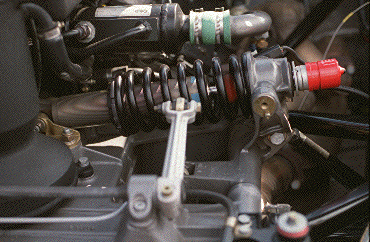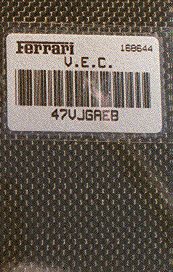
F50 Chassis

Ferrari took its "Formula 1 car for the street" design goal for the F50 seriously.
The best evidence of that can be found in the chassis and suspension. Many compromises
towards comfort, but which sacrifice performance, were not arrived at in the F50 design. Road
cars utilize rubber bushings (sometimes derisively called "bubble gum"
by engineers) to couple the suspension pieces to the chassis. They serve to
isolate road noise from the occupants, but they also flex which causes the suspension
alignment to change. This change, although small, affects handling and is a factor that
seperates road cars from race cars. On the F50, there are no rubber bushings.
The shock absorbers (developed by Bilstein) are in a pushrod arrangement,
common in race cars due to packaging considerations. They are connected to a electronic
control unit (ECU) which controls damping depending on speed, lateral/longintudinal
acceleration, and steering angle. The front track on the F50 is wider than the rear by 18 mm.,
thus promoting understeer.

The F50 chassis, like a modern race car, is constructed of Cytec Aerospace carbon fiber
and weighs only 102 kg. (224.4 lbs.). It features a torsional rigidity of 25,677 lb. ft./degree.
Also unusual for a road car is the engine mounting. As with many race and high
performance road cars, the F50 is a mid-engine design. In the F50, the engine is part of the
chassis structure; the front portion of the car is attached to the front of the engine and
the rear suspension and transmission is attached to the rear of the engine. Using the engine
block as a stressed member saves weight. However it also greatly increases the noise level for the
occupants since there are no engine mounts to provide isolation. Since engine block
strength is critical with this design approach, it is made of nodular cast iron as opposed
to aluminum.
Specifications
| Weight distribution, front/rear: |
42%, 58% |
| Front Suspension: |
Unequal length A-arms; coil spring/shock absorber; push rod control;
anti-roll bar |
| Rear Suspension: |
Unequal length A-arms; coil spring/shock absorber; push rod control;
anti-roll bar |
| Steering: |
Rack and Pinion |
Steering ratio
(lock to lock): |
3.3 |
| Turning circle: |
41.4 feet |
| Wheelbase: |
101.6 in. |
| Front track: |
1620 mm. (63.8 in.) |
| Rear track: |
1602 mm. (63.1 in.) |


|






